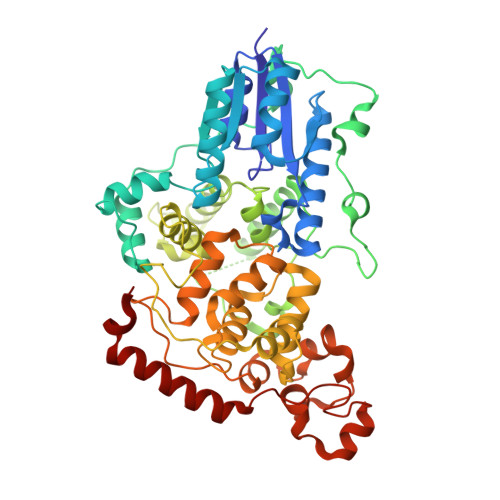Photopharmacological Manipulation of Mammalian CRY1 for Regulation of the Circadian Clock.
Kolarski, D., Miller, S., Oshima, T., Nagai, Y., Aoki, Y., Kobauri, P., Srivastava, A., Sugiyama, A., Amaike, K., Sato, A., Tama, F., Szymanski, W., Feringa, B.L., Itami, K., Hirota, T.(2021) J Am Chem Soc 143: 2078-2087
- PubMed: 33464888
- DOI: https://doi.org/10.1021/jacs.0c12280
- Primary Citation of Related Structures:
7D19, 7D1C - PubMed Abstract:
CRY1 and CRY2 proteins are highly conserved components of the circadian clock that controls daily physiological rhythms. Disruption of CRY functions are related to many diseases, including circadian sleep phase disorder. Development of isoform-selective and spatiotemporally controllable tools will facilitate the understanding of shared and distinct functions of CRY1 and CRY2. Here, we developed CRY1-selective compounds that enable light-dependent manipulation of the circadian clock. From phenotypic chemical screening in human cells, we identified benzophenone derivatives that lengthened the circadian period. These compounds selectively interacted with the CRY1 photolyase homology region, resulting in activation of CRY1 but not CRY2. The benzophenone moiety rearranged a CRY1 region called the "lid loop" located outside of the compound-binding pocket and formed a unique interaction with Phe409 in the lid loop. Manipulation of this key interaction was achieved by rationally designed replacement of the benzophenone with a switchable azobenzene moiety whose cis-trans isomerization can be controlled by light. The metastable cis form exhibited sufficiently high half-life in aqueous solutions and structurally mimicked the benzophenone unit, enabling reversible period regulation over days by cellular irradiation with visible light. This study revealed an unprecedented role of the lid loop in CRY-compound interaction and paves the way for spatiotemporal regulation of CRY1 activity by photopharmacology for molecular understanding of CRY1-dependent functions in health and disease.
- Centre for Systems Chemistry, Stratingh Institute for Chemistry, University of Groningen, Groningen 9747 AG, The Netherlands.
Organizational Affiliation:

















